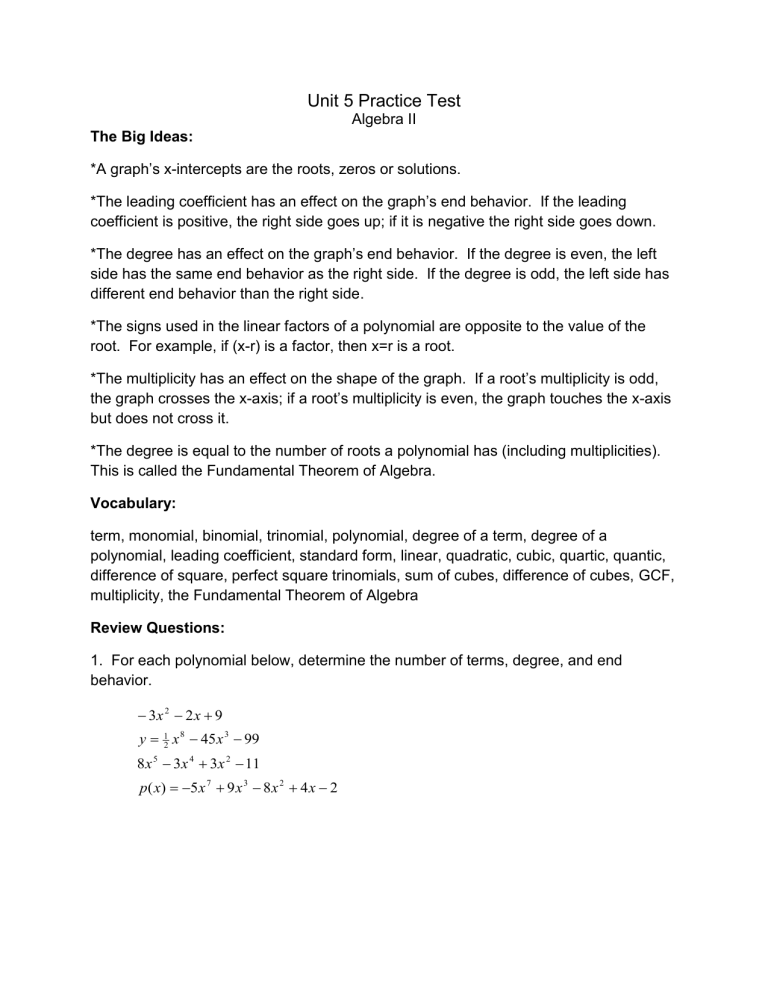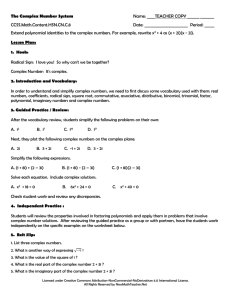Unit 5 Practice Test Algebra II The Big Ideas: *A graph`s x

Unit 5 Practice Test
Algebra II
The Big Ideas:
*A graph’s x-intercepts are the roots, zeros or solutions.
*The leading coefficient has an effect on the graph’s end behavior. If the leading coefficient is positive, the right side goes up; if it is negative the right side goes down.
*The degree has an effect on the graph’s end behavior. If the degree is even, the left side has the same end behavior as the right side. If the degree is odd, the left side has different end behavior than the right side.
*The signs used in the linear factors of a polynomial are opposite to the value of the root. For example, if (x-r) is a factor, then x=r is a root.
*The multiplicity has an effect on the shape of the graph. If a root’s multiplicity is odd, the graph crosses the xaxis; if a root’s multiplicity is even, the graph touches the x-axis but does not cross it.
*The degree is equal to the number of roots a polynomial has (including multiplicities).
This is called the Fundamental Theorem of Algebra.
Vocabulary: term, monomial, binomial, trinomial, polynomial, degree of a term, degree of a polynomial, leading coefficient, standard form, linear, quadratic, cubic, quartic, quantic, difference of square, perfect square trinomials, sum of cubes, difference of cubes, GCF, multiplicity, the Fundamental Theorem of Algebra
Review Questions:
1. For each polynomial below, determine the number of terms, degree, and end behavior.
3 x
2
2 x
9
8 y
x
5
1
2 x
8
3 x
4
45 x
3
3 x
2
99
11 p ( x )
5 x
7
9 x
3
8 x
2
4 x
2
2. Write a polynomial that meets the following criteria a) cubic binomial b) quadratic trinomial with leading coefficient of -8 c) quartic monomial d) polynomial with 6 terms and an odd degree
3. Determine the end behavior polynomials graphed below. What can be said about their leading coefficients and degrees?
4. Add ( 5 y
3
2 y
2
1 )
( y
2
2 y
3 )
5. Subtract ( x
3
3 x
2 x
4 )
( x
3
6 y
2
45 )
6. Multiply a) 8 x
3 y ( 4 x
2
35 x
3 y
2
) b) ( 10 p
3
3 x )( 10 p
3
3 x ) c) ( 3 x
2
4 x
5 )( x
2
3 x
3 ) d) ( x
3 )
4
7. Find the polynomial that has the linear factors of… a) ( x
3 )( x
3 )( x
1 ) b)
6 xxx ( x
2 )( x
2 )( x
1 )( x
5 )
Challenge: Find the polynomial that has the roots of x=4 with multiplicity of 2 and x=5 with multiplicity of 3.
8. Find the linear factors of the polynomial… a) x
7 x
5 b)
3 x
6
6 x
5
45 x
4
9. What are the roots (and multiplicities) to the polynomials in #8?
10. Use the linear factors below to create a sketch of the graph. a) 0 .
42 ( x
2 )( x
2 )( x
2 )( x
3 )( x
3 ) b)
x
3
( x
4 )( x
4 )( x
1 ) c) 4 x
2
( x
8 )( x
8 )( x
1 )( x
1 )( x
1 ) d)
6 x ( x
5 )( x
10 )( x
10 )( x
10 )( x
10 )( x
2 )( x
2 )
6.4 Solving polynomials
11. Solve the polynomial equation by graphing on a calculator a) x 3 x 2 x
1 b) x
3
5 x
2
3 x
7
0 c) 2 x
4
3 ( x
3 x
2
)
12. Solve the polynomial equation by factoring a) x
4
16
0 b) x
4
12
x
2 c) 4 x 5
32 x 2 d) 2 x
7
72 x
2
26 x
5






